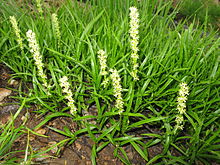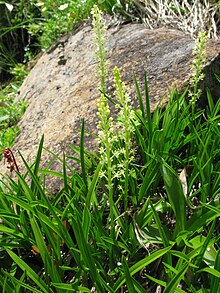Petrosaviaceae
| Petrosaviaceae | ||||||||||||
|---|---|---|---|---|---|---|---|---|---|---|---|---|

Petrosavia sakuraii , illustration |
||||||||||||
| Systematics | ||||||||||||
|
||||||||||||
| Scientific name of the order | ||||||||||||
| Petrosaviales | ||||||||||||
| Takht. | ||||||||||||
| Scientific name of the family | ||||||||||||
| Petrosaviaceae | ||||||||||||
| Hutch. |
The Petrosaviaceae are a family of the Petrosaviales plant order . The only two genera with only three or four species are distributed from China and Japan over parts of Southeast Asia ( Malaysia , Myanmar , Thailand , Vietnam ) to Borneo .
description

They are perennial herbaceous plants with slender and scaly rhizomes . The stem is erect, unbranched and thin, the leaves are arranged in a spiral. The species of the genus Petrosavia are mykoheterotrophic plants.
The terminal inflorescence is a panicle or cluster of more than ten flowers . The upright, hermaphrodite and stalked single flowers arise from the axils of small bracts , which are often faced with a bract . The six bloom are fused at the base of the inner petal circle are larger than the outer. The stamens of the six stamens are awl-shaped and fused with the base of the bracts, the anthers are egg-shaped and turned inward; the pollen monosulcat . The three styluses are short. The ovary is upper to medium-sized, follicles are formed. The seeds are elliptical and between 0.3 and 0.8 millimeters long.
Distribution area
The species of the order are distributed from China and Japan over parts of Southeast Asia (Malaysia, Myanmar, Thailand, Vietnam) to Indonesia (Borneo). They thrive in mountainous areas between 1000 and 1600 meters.
Systematics
The Petrosaviaceae family was established by John Hutchinson and the Petrosaviales order by Armen Tachtadschjan .
All taxa of the order have an eventful past and have been rearranged many times. The species of the order share relatively few morphological features with each other, which, however, due to their rarity in the Liliidae and in their combination, were understood to be sufficient to support the relationship determined by molecular genetics.
According to R. Govaerts, the order currently includes the following genera and species:
-
Japonolirion
Nakai : it contains only one species:
- Japonolirion osense Nakai : It occurs in northern and north-central Japan.
-
Petrosavia Becc. (Syn .: Miyoshia Makino , Protolirion Ridley ): It contains only three types:
- Petrosavia sakuraii (Makino) JJSmith ex van Steenis : It iswidespreadfrom Malesia, Japan , Myanmar , Vietnam , Taiwan to Guangxi and southeastern Sichuan .
- Petrosavia sinii (K. Krause) Gagnep. : This endemic thrives only in bamboo forests at altitudes of about 1000 meters only in the district (Shan) Dayao in east-central Guangxi.
- Petrosavia stellaris (K. Krause) Gagnep. : It is common in Malesia .
At the same time the genera Protolirion and Miyoshia went into the genus Petrosavia .
Japonolirion used to be part of the Melanthiaceae , but was occasionally treated as a separate family Japonoliriaceae. The family rank of the Petrosaviaceae, on the other hand, has been largely undisputed since 1934, but there was great uncertainty regarding the placement of the family, it was assigned to the Alismatales , Triuridales and Miyoshiales, it was not until 1997 that Takhtajan assigned the family the rank of its own order. This classification was confirmed by subsequent molecular genetic studies.
With an age that is given as around 123 million years ( Crown node age ), the Petrosaviaceae are probably the oldest recent family of the monocot ever.
literature
The information in this article was obtained from the following sources:
- Kenneth M. Cameron, Mark W. Chase, Paula J. Rudall: Recircumscription of the monocotyledonous family Petrosaviaceae to include Japonolirion. In: Brittonia. Vol. 55, No. 3, ISSN 0007-196X , 2003, pp. 214-225, doi : 10.1663 / 0007-196X (2003) 055 [0214: ROTMFP] 2.0.CO; 2 .
Individual evidence
- ↑ a b c d e f g Rafaël Govaerts (ed.): Petrosaviaceae. In: World Checklist of Selected Plant Families (WCSP) - The Board of Trustees of the Royal Botanic Gardens, Kew . Retrieved June 22, 2018.
- ↑ Thomas Janssen, Kåre Bremer: The age of major monocot groups inferred from 800+ rbcL sequences. In: Botanical Journal of the Linnean Society. Volume 146, No. 4, 2004, ISSN 0024-4074 , pp. 385-398, doi : 10.1111 / j.1095-8339.2004.00345.x .
